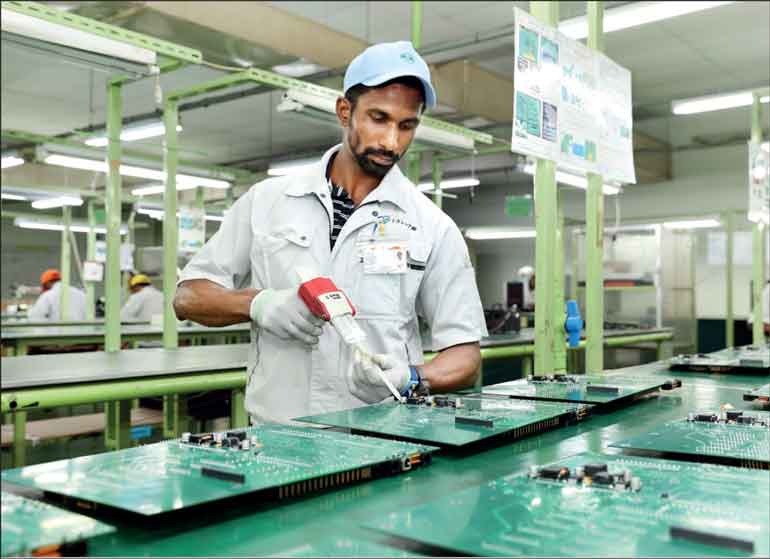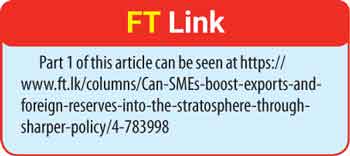Saturday Nov 08, 2025
Saturday Nov 08, 2025
Saturday, 8 November 2025 00:08 - - {{hitsCtrl.values.hits}}

 In yesterday’s edition of the Daily FT, we began to explore the hypothesis that Sri Lanka’s small and medium-sized enterprises (SMEs) have arguably being neglected by successive governments but also suffered from haphazard policymaking that fails to recognise their full potential.
In yesterday’s edition of the Daily FT, we began to explore the hypothesis that Sri Lanka’s small and medium-sized enterprises (SMEs) have arguably being neglected by successive governments but also suffered from haphazard policymaking that fails to recognise their full potential.
It is especially timely – given that the SMEs have the wherewithal, and the incumbent regime the political will – to develop the contention that these enterprises, in fact, hold the keys to unlocking more lucrative state coffers... A trajectory which, if taken at the right tangent by a savvy administration, can boost Sri Lanka’s under-threat foreign exchange reserves on the road ahead.
Pardon, your slip of paper is showing
Contradicting some of the extant research and providing contrary evidence of sharply delineated or specifically policy-driven state support for Sri Lankan SMEs, a paper was presented at an Asian confab over a decade ago (which, in itself, is a clue that little if anything of note has been said or done about the issue under consideration since then).
Presented at the 4th IMF-Japan High-Level Tax Conference for Asian Countries in Tokyo (2–4 April, 2013), the paper titled ‘Government Policy and Strategy for SME Development’ suggests that there is – or at least was, at the time – a discernible policy strategy in place in this regard.
Arguing that SMEs are being strengthened by the government, its authors J. P. D. R. Jayasekara and Anuradha Thilakaratna argue that “the government has assigned high priority to the SME sector to strengthen the SME [sic] as the backbone of the economy”.
They add that “steps have been taken by the government to form an entrepreneurial development environment by  introducing appropriate policy and providing greater incentives for SMEs”.
introducing appropriate policy and providing greater incentives for SMEs”.
Affirming that “SMEs are the central mechanism in the entire operation”, they observe that “government social welfare schemes are being redesigned to provide stimulus to SMEs”, and cite the instances of Thriposha; surgical gauze; selected pharmaceutical products; and school textbooks, uniforms, furniture” etc. as being cases in point where this policy-driven reality obtains (Jayasekara and Thilakaratna, 2013).
Further asserting that “a vibrant SME sector can play a key role in providing employment opportunities and high economic growth in post-conflict Sri Lanka”, the paper cites the then continuation of the fertilizer subsidy, and planting and replanting subsidies, as instances where it holds true that “SMEs need recognition, support, and considerable synergy to integrate with the real economy”.
This is a generalized observation however, not necessarily redounding to export-specific SME policies.
Noting from the government’s Budget 2011 that “all banks were required to set up an IFA from the reduction of the corporate income tax collected on banks from 35% to 28% and VAT on financial services from 20% to 12%”, Jayasekara et al. observe that “instructions were given to the banks to provide funding for SME development programs using the IFA”, adding that special bank branches were established to utilize these IFAs.
They also note that the government through these special bank branches would support SMEs “by providing guidance for marketing, financial management, changing energy to renewable sources, and increasing productivity and competitiveness” (Jayasekara and Thilakaratna, 2013).
It would also appear from Budget 2011 that a 50% government guarantee would be given for those banks providing loans under such IFAs to restructure Sri Lanka’s SMEs at the time in order to improve their respective performances.
All of this above seems to militate against the SMEs’ allegations that the state did not have – in fact, never had – an SME-specific policy to help small and medium businesses boost their potential export earnings, as it could be argued that all of the above strategies would aid it in the pursuit of internationalization.
Undermining a hobby-horse hypothesis
Further evidence undermining the hypothesis of state neglect of SMEs comes from Budget 2013 where “investment in sustainable energy sources, including solar power, and women’s entrepreneurship venture capital projects, up to 10 million Rs each” were added as sectors qualifying for state support of SMEs.
Similar incentives feature in “recent [2013] policy changes related to SMEs” as summarized by Jayasekara, et al., including:
All of the above (Jayasekara and Thilakaratna, 2013) – albeit being the state of play for SMEs over a decade ago – challenges the contention that Sri Lankan governments have not had a vision or a strategy to internationalize SMEs.
With that said – it does not necessarily invalidate the idea, as a mission to grow and develop SMEs could potentially serve to internationalize these very small and medium-sized enterprises.
For purposes of comparison, it is pertinent to note that Budget 2024 – over a decade after the abovementioned policy directives – allocated a sum of money totalling Rs. 50 billion for the development of SMEs in Sri Lanka per ‘Budget 2024: Paving the Way for the Nation’s Future’ (Presidential Secretariat, Nov 2023).
Presenting his government’s budgetary proposals for the year ahead, the then President Ranil Wickremesinghe also noted in Parliament in November 2023 that “SMEs have been badly affected by the economic crisis and COVID-19 pandemic” and concluded that “therefore, SMEs should be further strengthened, encouraged and facilitated”.
Speaking in his capacity as the country’s finance minister, the former head of state also pointed to a recent survey which revealed that “about 20% of such enterprises have either temporarily or permanently closed down”.
Despite the survey also revealing that there has been “a decrease in the performance volume of the currently operating enterprises”, there is only a general policy direction of fast-tracking “the journey towards a production economy” – with no nod to either internationalization of SMEs or the potential foreign exchange earnings therefrom in a milieu of economic recovery such as that which the island nation is currently undergoing.
Towards a new national policy framework
Previously, a National Policy Framework for Small and Medium Enterprise (SME) Development developed by the Ministry of Industry and Commerce at one time appears to have strategized what it terms as ‘policy interventions’ covering three pillars (policy vision, policy mission, policy objective).
The framework outlined a comprehensive strategy that defined SMEs, identified promising SME clusters with high potential, analysed policy interventions and strategies, and recommended implementation arrangements.
However, despite the trite and often repeated catchphrase featured in its conclusion (“SMEs are the backbone of the economy”), nowhere does this policy framework identify the extremely low contribution of Sri Lanka’s SMEs to national export earnings other than to pay lip-service to the affirmation that “the government of Sri Lanka is seeking to create the best possible GENERAL CONDITIONS [my emphasis, added] for SMEs with an SME Policy Framework”.
The framework, although comprehensive enough, is not specific as to facts, figures and features pertaining to internationalization of SMEs. Nor does it mention the export equation – focusing instead on SMEs as “a driving force for ‘growth and development’ … inclusive economic growth, regional development, employment generation and poverty reduction”.
Painting a distinctly contrary and positive picture of the contribution of small and medium-sized enterprises to the national economy is an assessment by the Export Development Board (EDB). The 2021 EDB paper, titled ‘The Role of SMEs in Sri Lankan Exports’, affirms that “in Sri Lanka, socio-economic development is given massive support from SMEs”.
Asserting that “the major export destinations for Sri Lanka are USA, India, Germany, Italy and China”, the same EDB says – contra the bleak picture painted by Dahanayake in the UoM’s Business Unit paper – that “Sri Lankan industrial exports accounted for 78.9% of all export earnings in 2019”. This, if taken at face value, would invalidate the hypothesis that all governments neglected SMEs badly.
Although the EDB does not explicitly attribute this percentage of export earnings to SMEs, it implies that small and medium businesses carry a substantial share of the credit for this by immediately following their assertions above with the observation that “most of these [i.e. the ones putatively earning almost 80% of export earnings] are located in rural areas” (EDB, 2021).
It does concede however that SMEs “face challenges when addressing financial reliability”. And as such agree with Kulasinghe, et al. that “this is mainly caused due to problems regarding financial access”.
Reiterating that “Sri Lankan SMEs are mostly rural-based” (per Kulasinghe, Han, Hoshino, Rathi and Lambert; ADB, 2018), the EDB also nods to “the need to improve the exports sector by promoting their integration to [sic] the exports value chain”.
It avers that “it has been identified as mandatory”, thereby arguably admitting an issue to the discussion, especially as they recognize that “the narrative of SMEs is focused on the bigger picture of how these entities serve the country’s GDP” and not necessarily its foreign exchange earnings.
In fact, the available literature surveyed predominantly follows the same or similar patterns. It focusses on the substantial potential of Sri Lankan SMEs rather than the need to develop particular strategies to boost export earnings through a strategic internationalization of the same.
Most of the expert or academic commentary on SMEs in Sri Lanka tend to:
All of this above is to the exclusion of visionary, strategic, organized or practical discussions of how to boost export earnings or to what extent SMEs can break the ‘5% barrier’. That could or should persuade the government’s dynamic team of SME driven policymakers that the hypothesis of the enterprises themselves has some merit and warrants further exploration.
(Editor-at-large of LMD | A time to sow again.)